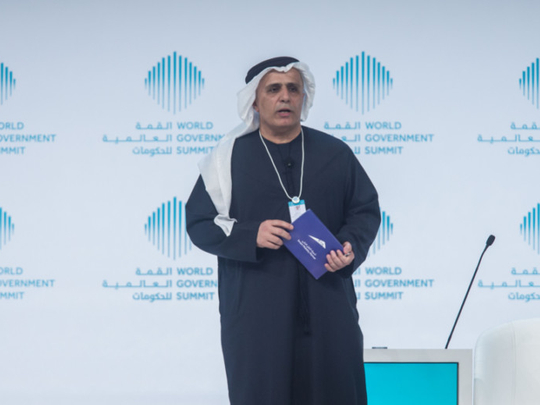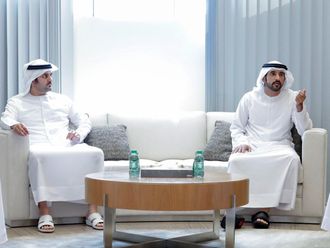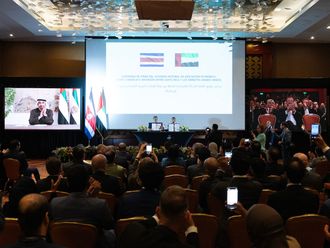
Dubai: One in four journeys in Dubai will be driverless by 2030, under the government’s plans.
And this goal will be achieved by fully autonomous buses, the metro, boats, trams, taxis and even autonomous aircraft.
Behind the push to make Dubai the world’s leader in autonomous transport is the Roads and Transport Authority (RTA), the emirate’s transport regulator.
“The Government of Dubai is leading the transition to driverless mobility in Dubai,” Mattar Al Tayer, the RTA’s director-general and chairman, said in a speech at the World Government Summit in Dubai. “Whereas in other cities and countries, it is the private sector that leads the process.”
Instead of being merely plans on paper, the RTA chief said that some of Dubai’s public transport goals were well under way.
Last year, 8.8 per cent of journeys in Dubai were made on the driverless Dubai Metro — more than 600,000 riders every day. The RTA expects that number to reach 12.2 per cent by 2030.
Serving alongside the metro is the Dubai Tram, which will in the future be fully driverless.
By 2030 6.4 per cent of journeys will also be made by driverless buses.
“Dubai has also started the test run of driverless mini-buses, vehicles and boats, besides considering the options of deploying driverless express shuttle buses, and taxis from some leading companies,” said Al Tayer.
The RTA’s strategy includes the involvement of “global competition” to draw in cutting-edge companies that deal with driverless transport. More details on this will be announced shortly, according to the transport body.
In total, Dubai’s autonomous mobility strategy is expecting to generate Dh22 billion dirhams per year, reduce mobility spending by 44 per cent, and curb demand for parking by 50 per cent.
As well as water, roads and rail, the RTA also plans to take to the skies — by as early as this July.
In cooperation with Chinese firm EHANG, the transport body is currently testing an Autonomous Aerial Vehicle (AAV).
Soaring on eight propellers, the aircraft carries one passenger for up to 30 minutes at a speed of 100 kilometres per hour.
“The AAV on display at the World Government Summit is not just a model but it has really flown in Dubai skies,” said Al Tayer. “RTA will spare no effort to launch the AAV in July 2017.”
No more drivers needed
Governments around the world have spent more than Dh2.2 billion to support research related to driverless vehicles — a figure that does not include investments by private firms.
There are five levels of driverless mobility, according to a US system of ranking. Level 1 means that the vehicle can stop by itself when approaching an obstacle. Meanwhile, Level 5 means the vehicle is completely autonomous — so no human intervention is needed at all.
Most commercially available technologies put the level of autonomy at about Level 3.
This means that a vehicle can be operated without a driver for limited periods in normal circumstances, but still needs human intervention under certain conditions.
Driverless transport faces four key challenges, both in Dubai and worldwide, Al Tayer told the audience at the summit.
These are: Infrastructure, which includes high-quality maps; and road markings; laws and legislation; safety and public acceptance; and technological requirements such as the efficiency of sensors and cameras.
Driverless cars on the roads could make some users uneasy, Al Tayer warned.
“Ordinary users may not be satisfied, particularly when the driverless vehicles share the same routes as ordinary ones,” he said.
“Governments must play a key role here in providing effective awareness to the public on the new technologies to the public in a way that promotes confidence.”
Local challenges
Some challenges are more unique to the region such as the sweltering climate.
Dubai’s high summer temperatures and humidity could take its toll on driverless tech, said Al Tayer.
“This may increase people’s reluctance to embrace modern technology,” he told the audience.
The transport body also has the need to drop passengers very close to their final destinations due to the fierce heat — prompting the need for many diverse types of transport.
Part of a successful transport strategy is to provide users with comprehensive and accurate data, Al Tayer said.
“To achieve this, we are currently constructing a unified centre for merging all information of various transit means,” the RTA chief said.
“The centre will be opened shortly.”
Dubai’s transport strategy, in numbers:
8.8 per cent: of the total journeys in Dubai are made on the driverless Dubai Metro
12.2 per cent: of the total journeys in Dubai will be on Dubai Metro by 2030
600,000: people take the Metro every day
13 years: left for Dubai to achieve its goal of one in four journeys on driverless transport
6.4 per cent: of the total journeys will be made by driverless buses by 2030
Dh2.2 billion: spent by governments to support research into driverless transport













